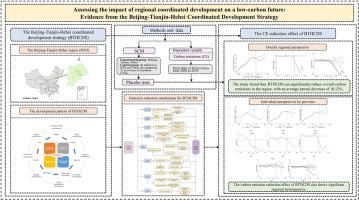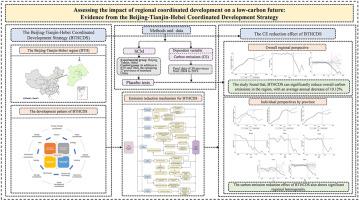评估区域协调发展对低碳未来的影响:来自京津冀协同发展战略的证据
IF 10
1区 环境科学与生态学
Q1 ENGINEERING, ENVIRONMENTAL
引用次数: 0
摘要
京津冀协同发展战略是我国探索生态文明建设的重要途径。能否有效降低碳排放(CE),不仅关系到战略实施的质量,而且对优化城市群低碳发展模式、推进我国 "双碳 "进程具有重要意义。本研究基于2004-2019年30个省份的面板数据,采用合成控制法(SCM)构建反事实路径,从区域整体层面和省级层面评估BTHCDS对CE减排的影响。结果表明,BTHCDS 在塑造区域低碳未来方面具有积极的引领作用,可推动京津冀地区整体 CE 以每年 9.38% 的速度下降。尽管在实施过程中会出现短期波动,但 BTHCDS 的 CE 减排效果总体上呈现稳步扩大的趋势。BTHCDS 的 CE 减排效果在各省之间呈现出异质性,但并不存在 "污染天堂"。本研究丰富了区域协调一体化发展对 CE 减排效应的研究,为其他城市群的低碳发展提供了重要的政策参考。本文章由计算机程序翻译,如有差异,请以英文原文为准。


Assessing the impact of regional coordinated development on a low-carbon future: Evidence from the Beijing-Tianjin-Hebei Coordinated Development Strategy
The Beijing-Tianjin-Hebei Coordinated Development Strategy (BTHCDS) is an important way for China to explore the construction of an ecological civilization. Whether it can effectively reduce carbon emission (CE) not only affects the quality of the strategy's implementation but also has important implications for optimizing the low-carbon development model of the urban agglomeration and advancing the “dual carbon” process of China. Based on the panel data between of 30 provinces between 2004 and 2019, this study employed the synthetic control method (SCM) to construct a counterfactual path and assess the impact of BTHCDS on CE reduction at both the whole regional and provincial levels. The results show that the BTHCDS has a positive leading role in shaping the region's low-carbon future and can drive the overall CE reduction in the Beijing-Tianjin-Hebei region at an annual rate of 10.43%. Despite short-term fluctuations in implementation, the CE reduction effect of BTHCDS has shown a steady trend of expanding overall. The CE reduction effects of BTHCDS exhibit heterogeneity across individual provinces, but there is no “pollution haven.” This study enriches research on the effect of regional coordinated integration development on CE reduction and provides an important policy reference for low-carbon development in other urban agglomerations.
求助全文
通过发布文献求助,成功后即可免费获取论文全文。
去求助
来源期刊

Journal of Cleaner Production
环境科学-工程:环境
CiteScore
20.40
自引率
9.00%
发文量
4720
审稿时长
111 days
期刊介绍:
The Journal of Cleaner Production is an international, transdisciplinary journal that addresses and discusses theoretical and practical Cleaner Production, Environmental, and Sustainability issues. It aims to help societies become more sustainable by focusing on the concept of 'Cleaner Production', which aims at preventing waste production and increasing efficiencies in energy, water, resources, and human capital use. The journal serves as a platform for corporations, governments, education institutions, regions, and societies to engage in discussions and research related to Cleaner Production, environmental, and sustainability practices.
 求助内容:
求助内容: 应助结果提醒方式:
应助结果提醒方式:


